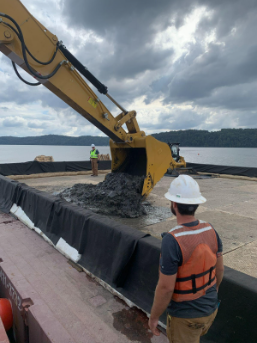Conowingo Sediment Characterization and Innovative and Beneficial Reuse Pilot
Main_Content
Since Conowingo Dam’s construction in 1929, sediment from the Susquehanna River watershed has been building up in its reservoir. Studies by the U.S. Geological Survey indicate the reservoir is now full, which means that more sediments and associated nutrients are washing downstream into Chesapeake Bay during storms. A 2015 study led by the Departments of Environment (MDE) and Natural Resources, the U.S. Army Corps of Engineers, the Susquehanna River Basin Commission and EPA’s Chesapeake Bay Program (CBP) found that those sediments and nutrients are contributing to dissolved oxygen impairments in Chesapeake Bay. CBP has calculated that an additional 6-million pounds of total nitrogen and 260,000 pounds of total phosphorus annually are now reaching Chesapeake Bay as a result of Conowingo infill.
Since the 2015 study, changing market conditions, increased stakeholder interest, and MDE’s dredged material reuse guidance have renewed interest in dredging as part of a comprehensive multi-state strategy to restore Chesapeake Bay. In 2018, Maryland issued a request for proposals for a Conowingo Sediment Characterization (SC) and Innovative Reuse and Beneficial Use (IRBU) pilot project to provide better information on the quality of sediments behind the dam, dredging costs, dredged material reuse options, scalability, and feasibility for addressing Conowingo’s impacts. In February 2019, Northgate-Dutra (ND) was awarded the SC and IRBU contract. The final SC report is available HERE and the final IRBU report available HERE.
|  Figure 1: Mechanically dredging the first scoop of material from Conowingo Reservoir, Oct. 2021. Photo courtesy of Matthew Rowe
|

Figure 2: Sediment coring setup from barges used to collect Conowingo sediments for characterization, Dec. 2020. Photo courtesy of Matthew Rowe.
| Key findings of the sediment characterization include: - There are an estimated 253 million total cubic yards of sediment in the Maryland portion of Conowingo Reservoir. These consist of predominantly silt and clay, with some intervening sand layers. Conowingo sediments are sandier upstream near the Maryland state line, and siltier as you get closer to the dam;
- Coal sand and fine particles were found at higher concentrations than observed in prior investigations (estimated range of 20-40% of total Conowingo sediments). This will influence future sediment reuse evaluations and may require preprocessing of material before reuse; and,
- Metals (arsenic, manganese, and thallium) and hydrocarbon concentrations in Conowingo sediments may restrict certain end uses. Maryland sediments are naturally higher in these metals, and the higher PAH levels are likely due to coal.
|
| Key findings from the IR/BU Report include: - Conowingo sediments have properties making them suitable for a range of potential reuses, including cement manufacturing, bioretention and topsoils, amended agricultural soils and stabilized fill;
- The costs of an environmental dredging program can be offset by the potential revenue generated from selling water pollution reduction credits and implementing different combinations of marketable reuses. The degree to which environmental dredging costs are offset will be determined by the specific dredging program and types of reuses, mode(s) of dredged sediments transportation, and water quality/nutrient reduction credit value generated from the dredging program; and,
- The large amount of coal sands and fines in Conowingo sediments will create both challenges and opportunities for marketable reuse. A technical feasibility and cost-effectiveness analysis of these opportunities were not evaluated in the IRBU report.; and
- Real world projects reusing Conowingo dredged material are feasible, safe, and scalable.
| Figure 3: Lab analysis of sediment cores from Conowingo Reservoir. The left core consists of coal sands, the right core consists of silt/clay sediments. Photo courtesy of Matthew Rowe. |
Maryland agencies are continuing to refine feasibility and cost determinations for a larger environmental dredging project, including:
- Working with the Bay Program Partnership on convening an expert panel to evaluate nutrient reduction credits from an environmental dredging project;
- Working with federal partners to develop a hydraulic and water quality model for Conowingo Reservoir that will inform the expert panel process and quantify nutrient reductions from environmental dredging; and,
At the watershed scale, Maryland is also working collaboratively with the CBP partnership on implementing a Conowingo Watershed Implementation Plan to reduce pollution in the Susquehanna River Basin upstream of Conowingo Dam. This work, coupled with the water quality of certification of Constellation Energy's continued operation of the dam, represents Maryland’s comprehensive strategy to reduce upstream and in-reservoir pollution and meet our 2025 Chesapeake Bay Restoration goals.